In this ultimate guide, you’ll find everything you need to know about a Whole Food Plant-Based Diet, including the benefits of adopting this lifestyle, how to heal your body, and the five essential steps to get you started.
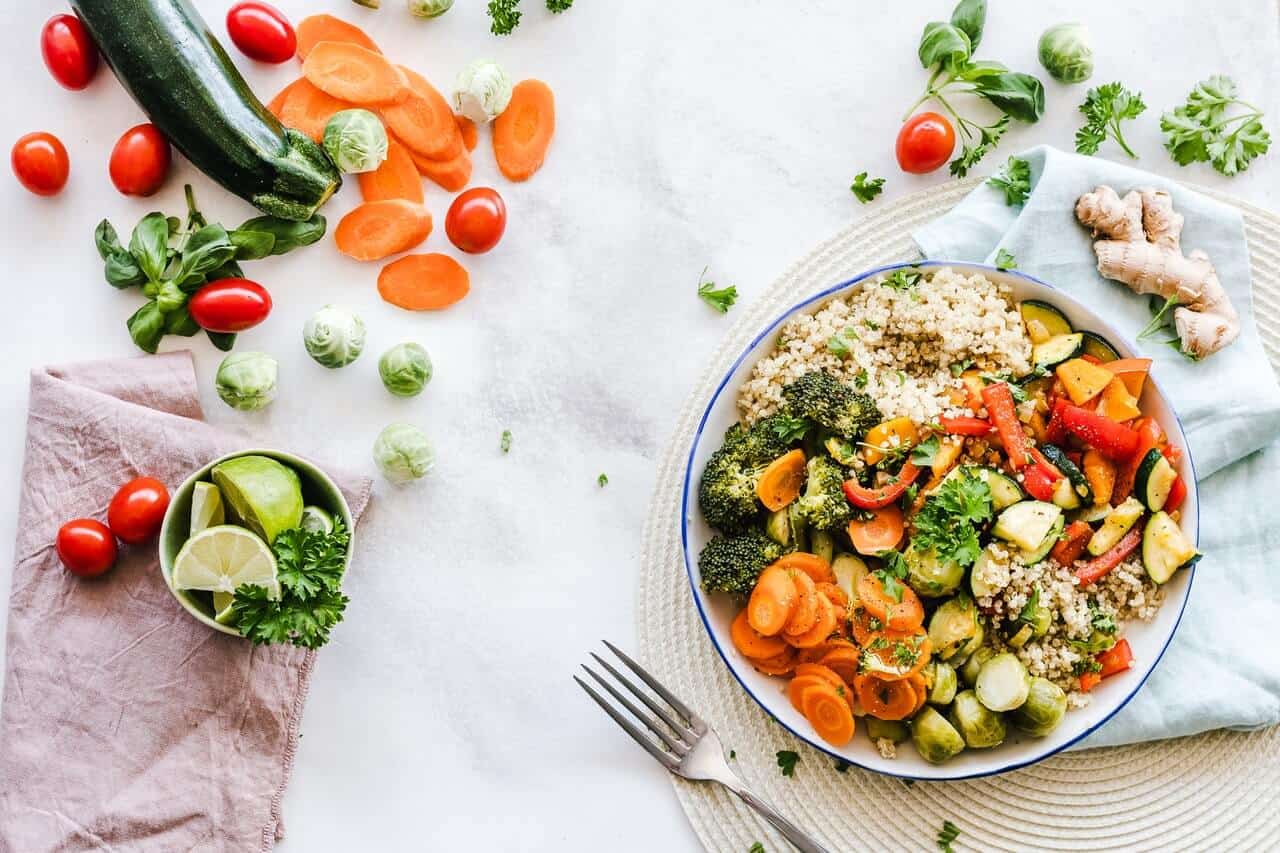
With so much conflicting diet information, knowing what to eat to feel your best is near impossible.
It can also be a contentious topic of conversation. My Keto and paleo friends are sure they eat the best diet, while my Pegan friends think they have the answer.
In truth, we’re all different people with different needs, but one thing is for sure: we need to eat more plants!
This article includes a beginner’s whole food plant-based diet shopping list, meal plan, and suggested readings.
Be sure to grab my FREE Plant-Based Fridge and Pantry Staples Shopping Guide.
What is considered a whole food plant-based (WFPB) diet?
Simply stated, following a whole food plant-based diet means consuming primarily natural whole plant foods, including fruits, vegetables, whole grains, nuts, seeds, tubers, and legumes, with minimal animal protein and dairy (10% or less) if you choose.
Whole Foods are natural foods that are unrefined and not processed.
Plant-Based are foods that come from plants and are not derived from animals or any animal ingredients, including animal protein, milk, eggs, and honey.
Many people following a plant-based diet do not consume animal protein or dairy, while some consume these foods in small amounts.
Whole food plant-based ingredients are as close to the way nature intended, meaning minimally processed, not packaged, or originating from a factory.
What are the health benefits of following a WFPB diet?
The overwhelming support through academic studies and research demonstrates that a plant-based lifestyle greatly reduces your risk of developing type 2 diabetes, hypertension, and cardiovascular disease.
Food has the power to deteriorate our health but also has the amazing power to heal our bodies. When you eliminate processed food and fill up on natural whole plant-based foods, your body can heal itself in many (not all) cases.
Improved Heart Health
A plant-based diet has the power to improve your heart health greatly. This diet can help you lose weight, lower cholesterol, and reduce your risk of heart disease.
Reduced Risk of Developing Cancer
It also has the potential to help you fight cancer. In the article Plant Power: Using Diet to Lower Risk of Cancer by the Mayo Clinic, they explain that those who eat less meat and fill up on healthy nutrient-rich foods such as plants and legumes consume more phytochemicals that protect cells from damage.
Those that eat plant-based also come with more fiber which is also associated with a lower risk of developing cancer.
In addition, dietician Angie Murad of the Mayo Clinic suggests that those following a vegan diet consume fewer calories on average, which helps them to maintain a healthy weight, which reduces the risk of developing some types of cancer.
Reduces Risk of Developing Type 2 Diabetes
In many cases, following this lifestyle has the potential to not only reduce your risk of developing type 2 diabetes but also to reverse it. By consuming low-calorie, nutrient-rich food sources and reducing or eliminating high-fat, high-sugar foods, you can improve and reverse type 2 diabetes.
Weight Loss, Improve Energy, and Reduce Inflammation
In addition, a plant-based lifestyle promotes weight loss and increases your fiber intake, which has been proven to lower cholesterol and blood sugar levels. When consuming fruits and vegetables and eliminating saturated fat found in animal products, you can see improvements in your skin and vision.
When you combine a healthy diet, moderate exercise, and stress reduction practices, you’ll have the full power to reverse overwhelm caused by chronic stress and heal your body from within.
How does a plant-based lifestyle help the environment?
In addition, a plant-based lifestyle helps the environment and does not promote animal cruelty. Whatever your reason for desiring to transition, you probably feel overwhelmed and confused.
You can go one of two ways. You can eliminate all animal products from your diet, take a more moderate approach, and reduce your intake to 10% or less. Whichever you choose, you will commit to filling your diet with mostly plant-based foods.
What can you eat on a WFPB diet?
There are so many delicious foods you can eat when following this lifestyle. I’ve created this infographic to help you visualize your plate when shifting to this new lifestyle.
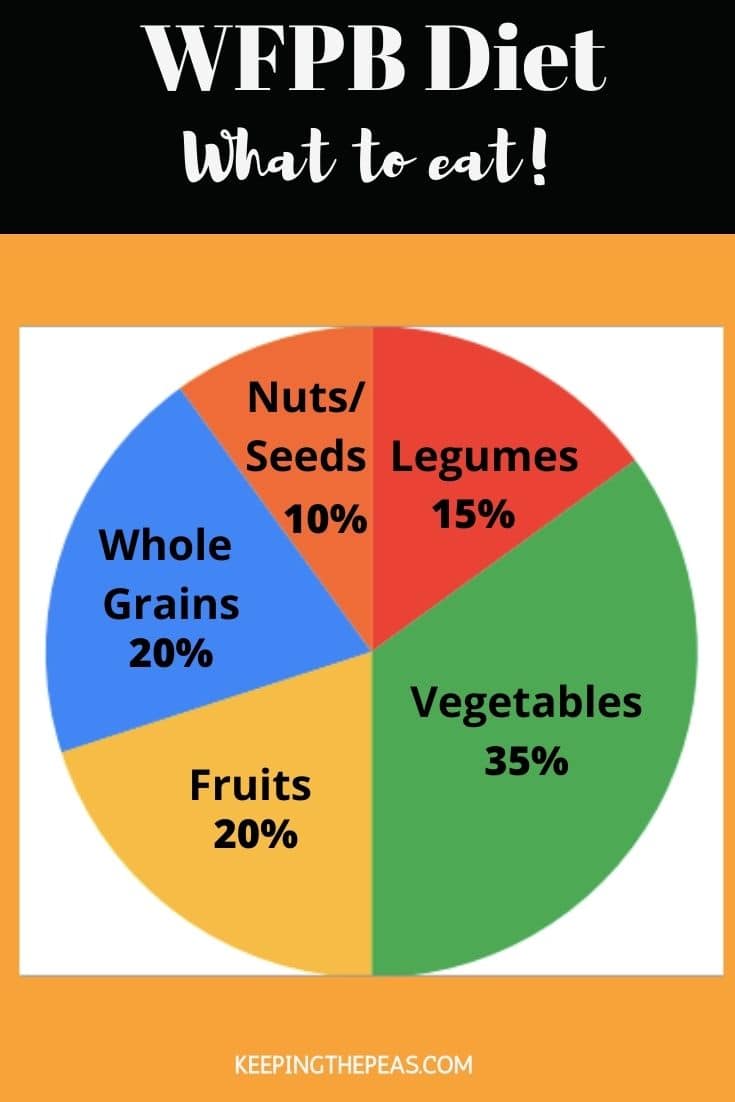
- Fruits-You can eat any fruit, including berries, bananas, apples, and more!
- Vegetables-All types of vegetables are allowed, from lettuces, spinach, kale, corn, and more!
- Herbs and Spices-All sorts of herbs and spices such as cilantro and parsley.
- Tubers-These are root vegetables such as potatoes, carrots, beets, parsnips, and sweet potatoes.
- Whole Grains-This includes brown rice, quinoa, oats, barley, farro, and whole grain cereals. You can also use whole-grain flour to create baked goods.
- Legumes-This includes beans such as chickpeas, black beans, kidney beans, lentils, and pulses.
- Nuts and Seeds-Small amounts of nuts, nut butter, and seeds, including almonds, cashews, peanuts, pumpkin seeds, walnuts, and more!
- Tofu/Tempeh-Made from soybeans, tofu, and tempeh are allowed in moderation.
- Plant-Based Milk-Unsweetened plant milk such as almond, rice, soy, cashew, coconut, and others are also in moderation.
What not to eat on a whole food plant-based diet?
- Animal Protein-This includes red meat, poultry (chicken, turkey), pork, seafood, and anything derived from an animal.
- Dairy-This includes milk, cheese, yogurt, sour cream, butter, and anything that contains dairy products.
- Eggs-No eggs, including egg whites.
- Oils-While oil is not derived from animals, it is processed and contains high amounts of fat. It is also not nutrient-rich. So all oils, including vegetable, avocado, coconut, and olive oils, are avoided.
- Sugar-Refined sugars are avoided. However, natural unrefined sugars are allowed in moderation.
- Refined Flours-This includes white flour, all-purpose flour, and any other type of refined flour.
Is a WFPB diet the same as a vegan?
I explain more in-depth in my article, Plant-Based vs. Vegan: What’s the Difference.
Vegan Diet: If following a vegan lifestyle, you do not consume animal products, including meat, dairy, eggs, and honey. However, a vegan diet does not eliminate sugars, refined flour, oils, or other processed ingredients derived from plant sources.
Whole Food Plant-Based Diet- When following this diet, avoid animal products like vegans and all processed ingredients, including oils, sugars, and refined flour.
How Do I Start A Whole Food Plant-Based Diet?
If you’re ready to transition to a plant-based lifestyle, I’ve identified five essential steps to get you started.
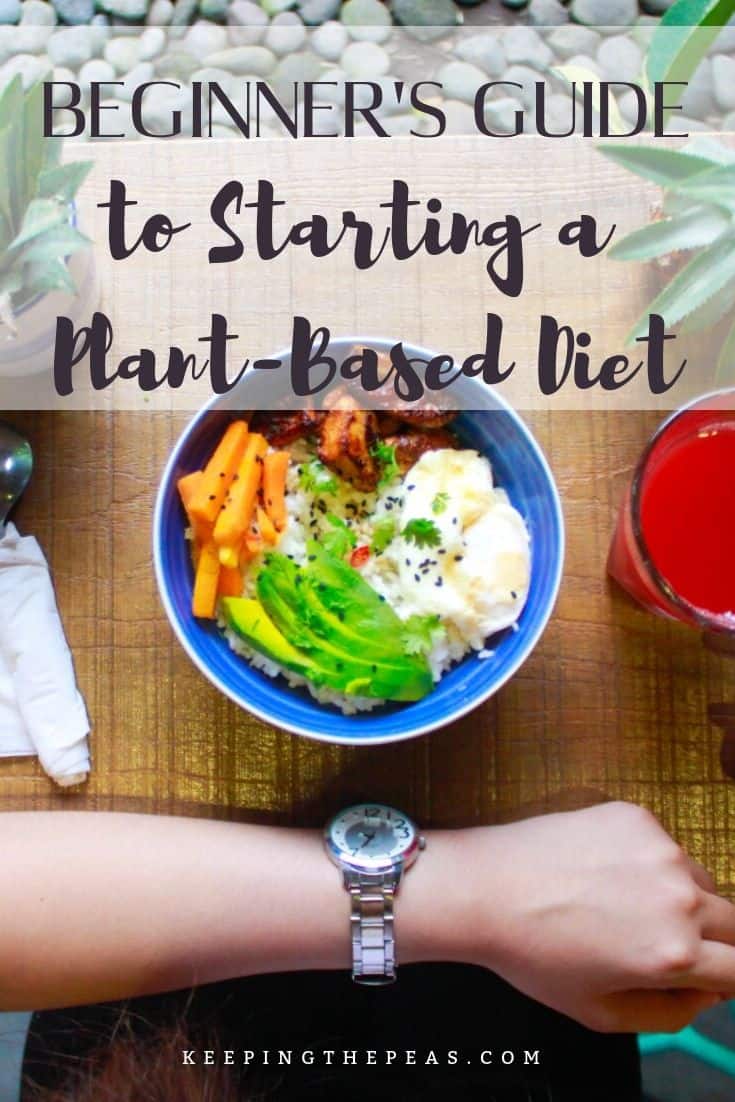
Step 1: Reduce Your Intake of Dairy
Begin by reducing your dairy intake, and try subbing with plant-based milk such as almond, cashew, soy, or rice milk. Breakfast is a good time to try subbing out milk.
A green spinach apple smoothie in the morning made with almond milk or coconut milk in your coffee is a good place to start.
Try different milk alternatives to see which one you like the best. When choosing a milk substitute, make sure you pick one that is unsweetened to reduce added sugar.
You can also try making your plant milk with this recipe for homemade oat milk.
If you’re not a milk drinker, remove the cheese from one of your meals daily. This is difficult for many who can’t imagine their life without cheese. If you’re a regular cheese eater, try removing it as your go-to snack and picking up a fruit or vegetable instead.
I do not recommend buying processed vegan cheese alternatives. If you’re used to eating regular cheese, these will disappoint. They do not taste like real cheese and often don’t melt the same way. In addition, they are highly processed, which does not follow a WFPB diet.
Try this homemade nut-free vegan nacho cheese sauce or vegan cheese sauce made with cashews. These homemade cheese sauces are much better than those in the store.
Step 2: Reduce Your Intake of Animal Protein/ Increase Your Intake of Fruits and Vegetables
Animal protein and fish are significantly reduced when converting to a whole-food, plant-based lifestyle.
Begin with removing animal protein from your lunch, and try adding plant-based protein in its places, such as beans, seeds, nuts, or quinoa. Try this delightful Vegan Tuna Salad Sandwich! It’s an easy recipe that has become one of my family’s favorites.
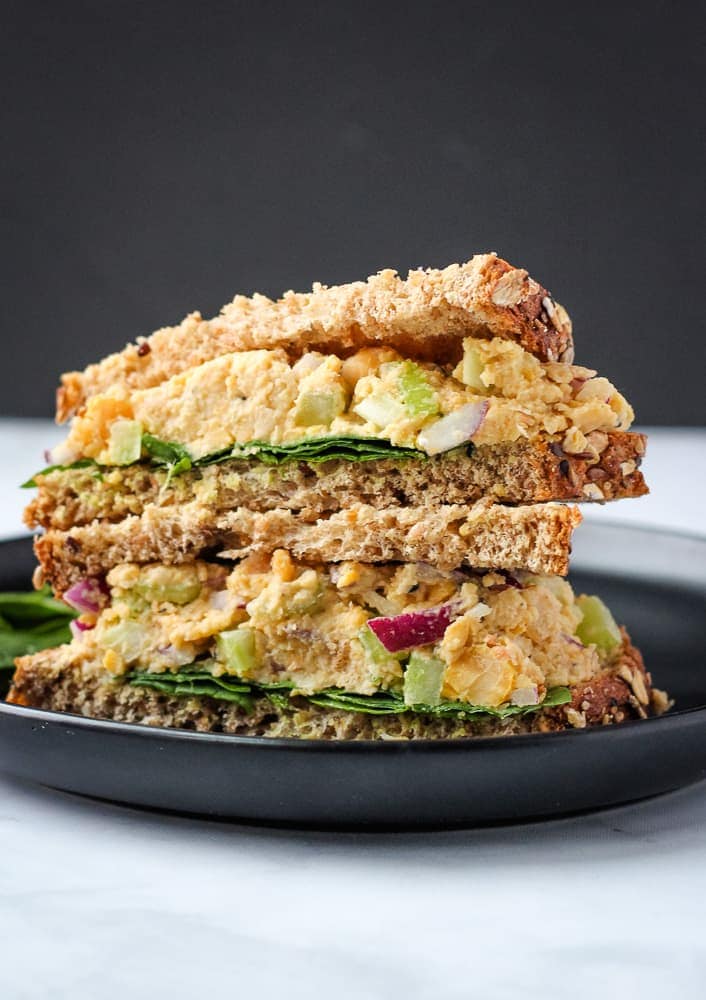
When you have a good handle on lunch, move towards removing animal protein from one of your dinners each week until you’ve reduced it to one or two nights a week of animal protein or none at all.
This recipe for Vegan Sloppy Joes made with lentils is a big hit in our house!
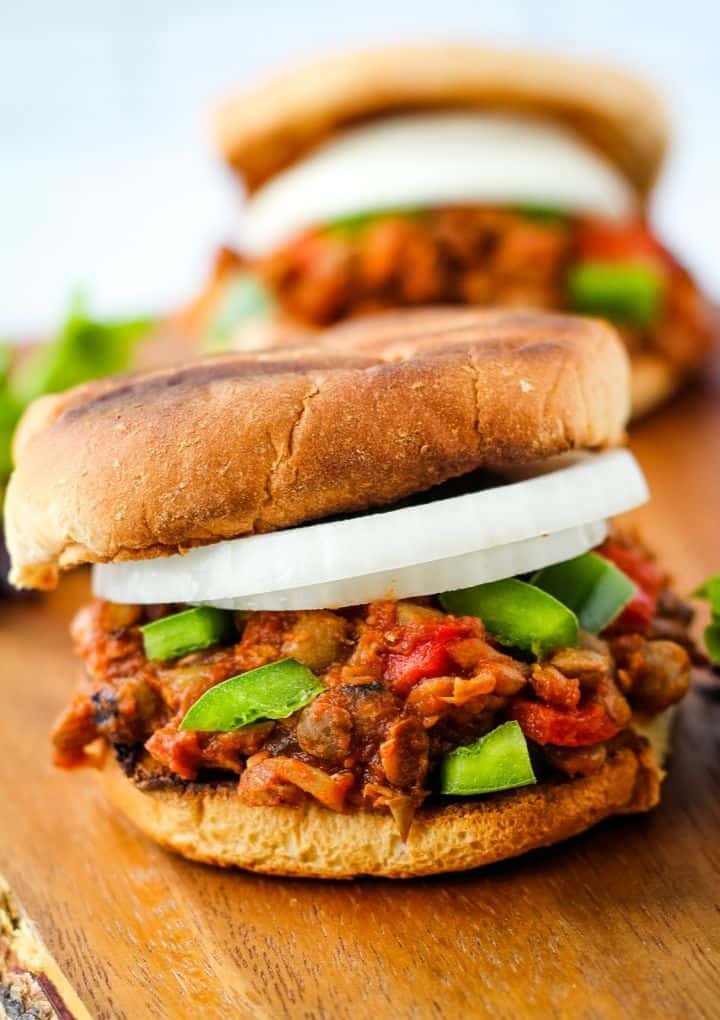
At your meals, increase your intake of vegetables and whole grains. Half your plate of vegetables, a little less than a quarter of your plate of whole grains, and a quarter of your plate of plant-based protein are helpful visuals when putting together your meals.
Step 3: Embrace Whole Grains
Carbs get a bad rep. Not all carbs are created equal. Some carbs are high in fiber and nutrients, and some are high in sugar and low in nutrients.
While the first is essential to ensuring you get a balance of the nutrients you need for optimal health, the latter is sure to leave you nutrient-deficient and increase your intake of sugar, putting you on a crash-and-burn roller coaster of high sugar intake.
You want to eat carbs that come in their whole and natural state. That means bananas, squash, potatoes, brown rice, whole-wheat pasta, whole-grain breakfast cereal, bread, green peas, and corn.
These foods are delicious, filling, and high in fiber and nutrients that will keep you feeling fuller longer.
Embrace whole grains, but avoid processed grains with enriched wheat flour, crackers, chips, pretzels, and cookies. If it’s packaged, avoid it. If it’s in its natural state, embrace it.
Begin by going through your pantry and donating or throwing out refined flour products. Look at the ingredients; if you see “enriched flour,” throw it out. Get rid of crackers, pasta, bread, bagels, pitas, cereals, and anything that does not include whole grains.
Stock up on whole-grain products. Use my Fridge and Pantry Guide as a tool.
It can be challenging to embrace grains if you’ve been on a high-protein, high-fat diet in the past. Read my article 3 Reasons You Shouldn’t Deny Yourself Carbs for more information.
Step 4: Consume Healthy Fats
Before transitioning to a WFPB diet, you likely got most of your fat from dairy and animal protein.
Now you will get your fat from nuts, nut butter, seeds, avocados, and limited amounts of oil.
As I mentioned above, it is recommended to eliminate oil on a WFPB diet, while some people use it sparingly.
This is up to you. If you choose to use oil in your cooking, go for high-quality olive or coconut oil.
When sautéing vegetables, use vegetable broth. Want a salad dressing, use vinegar. Need oil for baking, try applesauce.
You can get around using oil in cooking and dressings in many creative ways. Check out my 18 Oil-Free Salad Dressing and Sauce Recipes for some ideas!
Step 5: Increase Your Plant Protein
Plants have protein! I know it seems crazy, but it’s true!
Vegetables contain protein, but the highest protein concentration will come from beans, lentils, quinoa, and peas. You will also get protein from nuts and seeds, but I count this towards healthy fats.
Throw some beans in your salads, and make a soup, a chili, or a bean burger.
Here are some of my favorite recipes to get you started!
Recommended Reading
I’ve compiled a list of the 10 Best Plant-Based Diet Books. You’ll find informational books from reputable doctors and scientists. In addition, you’ll find easy cookbooks to help you with your journey.
A few books included are How Not to Die by Michael McGregor, MD. This is an in-depth look at the science and research behind adopting a plant-based lifestyle. It also shows how it will transform your health. McGregor also goes into the “how” of making a plant-based diet work in your life.
T. Colin Campbell is one of the pioneers behind the plant-based diet. The China Study is the most extensive study on the relationship between health and diet. This is the go-to for an in-depth research study on how changing your diet can change your health!
I also recommend his book Whole: Rethinking the Science of Nutrition.
Get your whole food plant-based meal plan!
I have a collection of easy and delicious recipes if you’re ready to try plant-based recipes. Be sure to grab my E-Book, 30 Simple and Easy Vegan Recipes, for a month of vegan meals planned for you!
The journey towards a plant-based lifestyle is a learning process. Some people are ready to embrace the challenges all at once, while others want to step into the transition. Reducing dairy and animal protein, embracing whole grains, and increasing your intake of fruits and vegetables and plant protein will go a long way in helping you look and feel better on the inside and out.
Do You Need to Take Vitamins or Supplements on a WFPB Diet?
While taking vitamins or supplements is unnecessary if you follow a well-balanced whole food plant-based diet, some specific vitamins and minerals are more difficult for vegans to get through their diet.
These vitamins and minerals include:
- Iodine
- Vitamin B12
- Vitamin D3
- Omega-3 Fatty Acids
- Iron
- Calcium
- Zinc
However, most vitamins are not vegan-friendly. I’ve created a list of the Best Vegan Multivitamins that include all the vitamins and minerals a vegan may need. You may also want to consider a vegan probiotic for gut health.
More WFPB Diet Resources!
- Plant-Based Vegan Grocery List for Beginners
- Top 10 Vegan Kitchen Tools
- How to Raise Plant-Based Kids
- Tips for Picky Eaters to Embrace Plant-Based Foods
Please comment below if you found this article helpful or have any additional questions. You can also follow me on Instagram, Pinterest, and Facebook for more family-friendly vegan recipes!
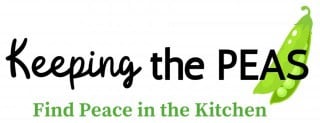

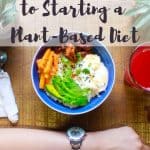
Joanne Jackson
I stumbled on your article, and am so glad I did. I appreciate that being WFPB is a journey that takes time, as I stopped eating meat about 3 years ago, but didn’t begin to stop dairy until the last year or so. At times it is still a struggle, as well as choosing healthy snacks over junk food. Your article really breaks it all down in detail, and I have benefited from reading it. Thanks for what you do.
Alison Corey
Hi Joanne! I’m so glad that my article was helpful for you. When trying to make any lifestyle change it’s important to allow yourself grace and time. Taking it at your own speed and introducing new changes as you’re ready for them. Way to go for making the transition to WFPB! You don’t have to be perfect. You should be proud of yourself for making the effort and taking it one step at a time!
Lola
I have been vegan for over a year. I am anemic and b12 deficit. I live this way of eating but find at times the info can be overwhelming. I like the easy way you have provided your research. Thank you.
Helene Thomas
I’ve been plant-based all my life, but the whole food thing is a more recent addition. AMAZED at how removing refined foods, especially the free fats, is helping my arthritis! Thank you for the good advice and good recipes.
Alison Corey
You’re so very welcome! It’s fantastic to hear an account of how eating plant-based free of processed ingredients is helping you improve your health! It’s challenging to make a radical lifestyle change, but I’m thrilled to hear you’re making it work and reaping the benefits!
Kay
Sounds solid. I had started this week, then got cramping and light diarrhea. Went at fibers too fast. I like the way you’ve broken this down, about limiting meat at lunch, then later eliminating some meat on evening meals
Alison Corey
I’m so glad you found this article helpful! When you jump into a new diet too quickly it can be challenging mentally and physically. I wish you all the best in your transition!